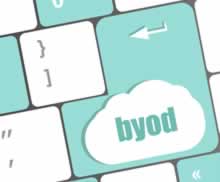BYOD is growing more popular, and school networks should keep certain points in mind as they contemplate implementation
 As mobile devices and bring-your-own-device (BYOD) initiatives become more common in classrooms across the U.S., school administrators and IT leaders are tasked with managing an influx of devices and maintaining a balance between network security and flexibility for students.
As mobile devices and bring-your-own-device (BYOD) initiatives become more common in classrooms across the U.S., school administrators and IT leaders are tasked with managing an influx of devices and maintaining a balance between network security and flexibility for students.
An increasing number of students have access to personal mobile devices, such as smartphones or tablets, which they are able to bring to school for academic use. Schools often maintain a classroom or library set of devices for students who do not own or who are not allowed to bring their own devices to school.
While access remains a critical issue, schools also grapple with ensuring their networks are prepared to support a large number of teacher- and student-owned devices. Here, Chris LaPoint, vice president of product management at SolarWinds, shares three key things a school should consider in the move to prepare its infrastructure for BYOD.
(Next page: Important considerations for school networks)
1. Assess the network. “Many schools struggle with trying to determine what is on the network,” LaPoint said. “What devices are on your network, and where are they connecting—to the physical network, or via wireless?” In order to determine these things, school IT leaders can leverage their existing wireless access controllers to discover this information as students show up on the school’s network and connect with mobile devices. Schools also can use DHCP servers, which assign IP addresses to devices, to identify devices accessing the school network. Administrators also could opt for device tracking software, which leverages existing infrastructure to monitor what is connecting to the school’s network.
2. Understand the impact on the network. “If you have hundreds of students bringing in mobile devices and streaming on the network, what kind of load is that going to place on your network?” LaPoint asked. “Do you need to prevent access to certain things? How do you plan for that? Do you need to plan for additional capacity? Do you need to examine different policies to restrict what the network can be used for?” Various software solutions can address these concerns. One of the most common, LaPoint said, is combining traffic analysis software and device tracking software to leverage flow-based information from the network to pinpoint how often the network is used for certain functions, where bandwidth hogs are located, who is using what devices, what devices are consuming what level of bandwidth, and where they are connecting to the network.
3. Be able to track stolen devices and be aware of digital rights laws. If network administrators can track stolen devices, they can determine if a stolen device reappears on the school or district network based on the IP address or MAC address. Another big consideration is enforcement of digital rights laws. Many tools exist that enable illegal music or file downloading, and when students bring their own devices to school, it can create a problem when it comes to preventing this type of activity, LaPoint said.
- Prioritizing inclusivity in game-based learning - April 22, 2024
- Friday 5: Universal Design for Learning - April 19, 2024
- Educators love their edtech, but want more training - April 18, 2024


Comments are closed.